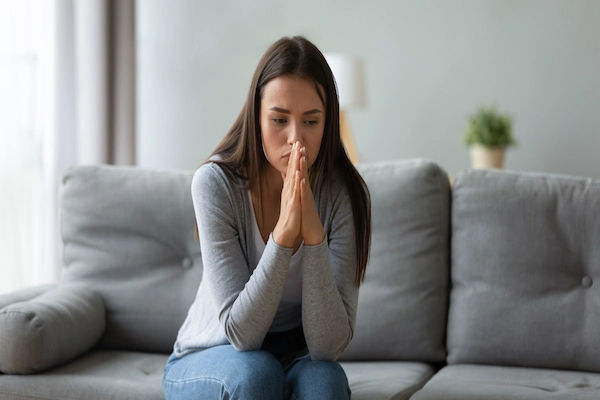Guide to Mental Health And Behavioural Sciences/live Stress Free Life Forever
Know about mental health, behavioural sciences, daily habits for stress free life, core pillars, early warning signs, medications, monitoring, crisis preparedness, safety and more.

Written by Dr. Siri Nallapu
Reviewed by Dr. D Bhanu Prakash MBBS, AFIH, Advanced certificate in critical care medicine, Fellowship in critical care medicine
Last updated on 21st Oct, 2025

Introduction
Stress touches every part of life, from the thoughts we think to the habits we repeat. While it’s tempting to aim for a stress‑free life forever, science suggests a better approach: build mental health and behavioural skills that make you resilient, steady, and ready. This guide translates leading research on mental and behavioural health into a practical, step‑by‑step plan you can start today. You’ll learn the difference between mental and behavioural health, how to spot early warning signs, and what to do each day to protect your mood, energy, and sleep. You’ll also find guidance for different life stages, what treatments work, when to seek help, and how to craft a seven‑day “stress‑smart” practice plan you can repeat for life. If you’ve wanted a handbook to living well—clear, compassionate, and realistic—this is it.
Mental vs Behavioural Health: Clear Definitions
Mental health refers to your emotional, psychological, and social well-being—how you think, feel, and relate. It includes the capacity to handle stress, work productively, and contribute to the community. Mental health naturally fluctuates, and it exists on a spectrum from thriving to challenged. The WHO emphasises that mental health is shaped by biological, social, and environmental determinants, not solely by individual willpower.
Behavioural health focuses on the actions and habits that influence your wellbeing: sleep, nutrition, physical activity, substance use, digital use, coping strategies, and treatment adherence. It includes how behaviours affect or reflect conditions like anxiety, depression, or substance use disorders [4]. Behavioural health also encompasses prevention—building daily patterns that reduce the risk of mental health problems over time.
The overlap matters. Daily behaviours affect mood (for example, insufficient sleep elevates stress reactivity), and mental state influences behaviour (low mood drives avoidance). For practical purposes, think of mental health as “what you experience on the inside,” and behavioural health as “what you do on the outside” that either helps or hinders recovery. Integrating both gives you a fuller toolkit for stress management techniques for daily life and long‑term wellbeing.
Consult a Top General Practitioner for Personalised Advice
Why “Stress‑Free Forever” Is a Myth—and What to Aim For Instead
Your body evolved a stress response to keep you safe. Acute stress (a deadline, a near miss on the road) mobilises the nervous system—heart rate rises, attention narrows. This can be helpful in short bursts. Chronic stress—ongoing financial strain, caregiving without respite, persistent uncertainty—keeps the stress system stuck “on,” increasing risk for anxiety, depression, sleep problems, and physical conditions like hypertension [8][9]. The APA’s Stress in America reports consistently show high levels of stress across age groups, with finances, health, and work among the top stressors.
Rather than chasing “stress‑free forever,” aim for stress‑smart living: reduce unnecessary stressors, respond skillfully to unavoidable ones, and recover fully after peaks. Use a “stress load ledger” to visualise inputs and outputs:
- Inputs (load): demands, deadlines, social conflict, noise, news, screens.
- Buffers (recovery): sleep, movement, mindful pauses, social support, nature.
- Levers (changeable factors): caffeine, alcohol, schedules, boundaries.
Reduce load where you can, increase buffers daily, and adjust levers weekly. Over time, this turns resilience training from a concept into a routine. Long‑tail terms like mind‑body connection and stress hormones matter here: you’re not just changing thoughts, you’re recalibrating a physiological system for steadier living.
Early Warning Signs You Shouldn’t Ignore
Stress and mental health challenges often whisper before they shout. Common early signals include:
- Mood: irritability, persistent low mood, and loss of interest in activities.
- Sleep: trouble falling asleep, waking at 3–4 a.m., or oversleeping.
- Focus: brain fog, forgetfulness, struggling with simple tasks.
- Body: headaches, jaw clenching, stomach upset, muscle tension.
- Behaviour: avoidance, procrastination, increased alcohol or screen time. The CDC and NIMH list similar signs and
encourage early help‑seeking [2][3].
Two‑week rule of thumb: If symptoms persist beyond two weeks or interfere with work, school, or relationships, consult
a healthcare professional. If symptoms persist beyond two weeks, consult a doctor online with Apollo24|7 for further evaluation. For severe symptoms—thoughts of self‑harm, losing touch with reality, panic that won’t subside—seek urgent help immediately.
Core Pillars of Daily Mental Health
The core pillars include:
Sleep hygiene made practical
- Sleep is the master recovery system. Poor sleep amplifies amygdala reactivity (more anxiety) and impairs the prefrontal cortex (poorer decision‑making). Practical steps:
- Regular schedule: same wake time daily; anchor morning light exposure.
- Bedroom: cool, dark, quiet; use a wind‑down routine (stretching, reading).
- Reduce stimulants: limit caffeine after noon; avoid alcohol near bedtime.
- Digital boundary: screens off 60 minutes before sleep. Blue light and cognitive arousal delay sleep onset.
Movement as medicine
Physical activity reduces symptoms of anxiety and depression and stabilises energy. You don’t need perfection, aim for
consistency:
- Habit stack: 10 minutes of brisk walking after meals (behavioural activation).
- Mix types: cardio for mood, strength for confidence and metabolic health, gentle yoga for flexibility and calm.
- Set “minimums”: even 5 minutes counts on busy days. The stress management literature highlights exercise as one of
the most effective coping strategies [8][9].
Nutrition for mood and energy
- Stabilise blood sugar: include protein and fibre at each meal to prevent energy crashes.
- Omega‑3 sources (fish, flax, walnuts) support brain health.
- Hydration affects alertness; carry a water bottle.
- Limit high‑sugar snacks, which can worsen mood swings. While not a cure, dietary patterns are linked to mental well-
being.
Mindfulness and self‑compassion
Mindfulness reduces rumination and stress; self‑compassion buffers shame and perfectionism. Start with 5 minutes of
breath awareness or a guided scan. Self‑compassion exercise: when you notice self‑criticism, pause—Name it,
Normalise it (“others feel this too”), Nurture yourself (“what would I say to a friend?”).
Behavioural Design: Make Healthy Choices the Default
The healthy choices include:
Micro‑habits and friction design
You’re not just a person with willpower, you’re a person in an environment. Design that environment so the easiest
option is the healthy one:
- Reduce friction for good habits: put walking shoes by the door; pre‑fill your water bottle; place your journal on your
pillow. - Increase friction for unhelpful habits: log out of social media; keep snacks out of sight; use app timers.
Digital boundaries and dopamine balance days
Notifications fragment attention and increase stress. Try:
- Batch check: messages 2–3 times per day.
- Phone‑free zones: dining table, bedroom.
- Dopamine balance day (once weekly): remove high‑stimulus activities (social media, gaming, ultra‑processed snacks)
and replace with steady‑state rewards (walk in nature, cooking, paper reading). This can restore motivation and reduce
anxiety.
The 5‑minute activation rule
When stuck, commit to 5 minutes of the task, then reassess. This leverages behavioural activation—small action often
precedes motivation.
Special Populations and Life Stages
Kids and teens
- Sleep and screens: prioritise consistent bedtimes; remove devices from bedrooms.
- School stress: teach problem‑solving scripts; normalise asking for help.
- Activities: balance academics with play and unstructured time.
New parents and caregivers
- Normalise mood shifts; screen for postpartum mood disorders.
- Build a “care web”: rotating help for meals, errands, and rest.
- Micro‑recovery: 10‑minute rests while the baby naps; short outdoor walks.
Midlife and older adults
- Role strain (work, caregiving) is common—use delegation and boundaries.
- Movement preserves function and mood; adds strength and balance work.
- Connection matters: join intergenerational activities; volunteer to boost purpose.
If persistent mood changes, sleep disruption, or loss of interest last more than two weeks, consult a healthcare
professional. If your condition does not improve after trying these methods, book a physical visit to a doctor with
Apollo24|7.
Medication and monitoring
For moderate to severe conditions, medications like SSRIs or SNRIs can be effective. Monitoring side effects and
progress is essential—combine with therapy when possible [3]. If medication is considered, discuss risks and benefits
with a clinician. If symptoms persist beyond two weeks, consult a doctor online with Apollo24|7 for further evaluation.
Blended self‑care + professional care
Best outcomes often come from combining approaches: structured self‑care, therapy, possible medication, and social
support [2][3][7]. Consider group programs, peer support, or mental health first aid training for families.
Your 7‑Day “Stress‑Smart” Practice Plan
This is a repeatable micro‑program to reset your system.
Daily non‑negotiables (all days)
- Sleep: lights out 7–8 hours before desired wake time; 60‑minute screen‑free wind‑down.
- Movement: 20–30 minutes (walk after meals + 10 minutes strength).
- Mind: 5 minutes of breath or body scan; 2 minutes self‑compassion.
- Connection: one deliberate check‑in (call, text, walk).
- Nourish: protein + fibre at each meal; hydrate.
Day‑by‑day focus
- Day 1 (Reset): Declutter your digital spaces; set app limits; prep your environment (shoes by door, journal on pillow).
- Day 2 (Sleep anchor): Morning light within 60 minutes of waking; caffeine cutoff noon.
- Day 3 (Move more): Add a second 10‑minute walk; one set of bodyweight exercises.
- Day 4 (Mindfulness): Try 10 minutes of guided meditation; 3 mindful breaths before each meal.
- Day 5 (Connection): Plan a walk‑and‑talk or shared meal.
- Day 6 (Dopamine balance day): Avoid high‑stimulus inputs; choose nature, paper books, slow hobbies.
- Day 7 (Reflect + plan): Review your stress load ledger; identify one load to reduce and one buffer to boost next week.
When to Get Help—and How to Start
Choosing between self‑help, therapy, and medication
- Mild, short‑term symptoms: start with structured self‑care and self‑help tools.
- Persistent or moderate symptoms: consider therapy (CBT, ACT, IPT).
- Severe symptoms, functional impairment, or safety concerns: seek immediate professional care; medication may be
indicated [3][7][9].
Online care, privacy, and continuity
Telehealth can increase access and reduce stigma barriers. Keep consistent appointments and use secure platforms. If
symptoms persist beyond two weeks, consult a doctor online with Apollo24|7 for further evaluation.
Crisis Preparedness and Safety
Red flags for urgent help
- Thoughts of harming yourself or others
- Hallucinations or severe confusion
- Panic attacks that do not subside, chest pain, or shortness of breath
- Inability to care for basic needs
Contact local emergency services or a crisis line immediately. SAMHSA and NHS provide crisis resources by region. Keep key numbers visible for all household members.
Safety plans and support networks
- Identify triggers and early signs.
- List coping steps and emergency contacts.
- Secure medications and reduce access to means when risk is elevated.
- Share the plan with trusted people and your clinician.
Myths vs Facts in Mental and Behavioural Health
- Common myths
- Strong people don’t need help.”Fact: Seeking help is a strength; early intervention improves outcomes.
- Stress is all in your head.” Fact: It’s also in your body; chronic stress alters hormones and inflammation.
- Therapy takes years before it works.” Fact: Many evidence‑based therapies have benefits within weeks.
- Digital detox is all or nothing.” Fact: Small boundary shifts yield big gains.
Putting It All Together: Your Long‑Term Wellbeing Map
Quarterly reviews and habit stacking
Every 12 weeks, review your stress load ledger and metrics. Keep what works; retire what doesn’t. Stack habits: when
one is stable, add a small new one (e.g., after morning light, do 5 minutes of mobility).
Adjusting for life changes
When life shifts (new job, baby, caregiving), resize routines. Use minimum effective doses rather than stopping
completely. This prevents the “all‑or‑nothing” trap and sustains mental health gains.
Conclusion
A stress‑free life isn’t realistic, but a stress‑smart life is within reach. By understanding how mental and behavioural
health work together, you can redesign your days so that the healthiest choices become the easiest ones. Start with the pillars—sleep, movement, nourishment, mindfulness, and connection—and protect them with behavioural design: micro‑habits, digital boundaries, and environment tweaks that reduce friction. Build resilience by regularly tuning your stress load ledger: reduce unnecessary pressures, create reliable buffers, and adjust levers like caffeine, schedules, and boundaries. When you need more support, choose evidence‑based care. Cognitive behavioural strategies, behavioural activation, therapy, and sometimes medication can accelerate recovery and stability. If symptoms persist beyond two weeks or interfere with daily life, consult a doctor online with Apollo24|7 for guidance, and consider home collection for labs (such as vitamin D or HbA1c) if your clinician recommends checking physical contributors. Most importantly, make your plan sustainable: use a 7‑day reset, track simple metrics, review quarterly, and adapt when life changes. Over time, these steps compound into steadier energy, clearer thinking, and a stronger sense of meaning. Your next best step? Pick one minimum you can start today—five mindful breaths, a 10‑minute walk, or an earlier bedtime—and let momentum build.
Consult a Top General Practitioner for Personalised Advice
Consult a Top General Practitioner for Personalised Advice

Dr. Mainak Baksi
General Practitioner
13 Years • MBBS , MD (MPH)
Howrah
Mainak Baksi Clinic, Howrah
(50+ Patients)

Dr Suseela
General Physician
5 Years • MBBS
Bengaluru
Apollo Medical Center, Marathahalli, Bengaluru

Dr. Rajib Ghose
General Physician/ Internal Medicine Specialist
25 Years • MBBS
East Midnapore
VIVEKANANDA SEBA SADAN, East Midnapore

Dr. Shaik Abdul Kalam
General Practitioner
3 Years • MD (Physician)
Visakhapatnam
Apollo 24|7 Clinic - Andhra Pradesh, Visakhapatnam
(150+ Patients)

Dr. Rohinipriyanka Reddy
General Practitioner
9 Years • MBBS
Hyderabad
Apollo 24|7 Clinic, Hyderabad
Consult a Top General Practitioner for Personalised Advice

Dr. Mainak Baksi
General Practitioner
13 Years • MBBS , MD (MPH)
Howrah
Mainak Baksi Clinic, Howrah
(50+ Patients)

Dr Suseela
General Physician
5 Years • MBBS
Bengaluru
Apollo Medical Center, Marathahalli, Bengaluru

Dr. Rajib Ghose
General Physician/ Internal Medicine Specialist
25 Years • MBBS
East Midnapore
VIVEKANANDA SEBA SADAN, East Midnapore

Dr. Shaik Abdul Kalam
General Practitioner
3 Years • MD (Physician)
Visakhapatnam
Apollo 24|7 Clinic - Andhra Pradesh, Visakhapatnam
(150+ Patients)

Dr. Rohinipriyanka Reddy
General Practitioner
9 Years • MBBS
Hyderabad
Apollo 24|7 Clinic, Hyderabad
More articles from Stress
Frequently Asked Questions
1) What is the difference between mental and behavioural health?
Mental health is your emotional and psychological state; behavioural health is the daily actions (sleep, activity, substance use, coping) that shape and reflect it. Both matter for stress management techniques for daily life.
2) How can I tell if stress is becoming a problem?
Warning signs include persistent sleep issues, irritability, brain fog, body tension, and avoidance. If signs last beyond two weeks or impair function, seek care. If symptoms persist beyond two weeks, consult a doctor online with Apollo24|7.
3) What is behavioural activation, and how does it help?
It’s scheduling small, meaningful activities to counter avoidance and lift mood. Start with 5–10 minutes of a valued task; consistency matters. It’s an evidence‑based mental health strategy.
4) Are digital detoxes necessary for mental well-being?
Full detoxes aren’t required; targeted digital boundaries (batch checks, no phones in the bedroom) often deliver most benefits for digital detox and mental wellbeing.
5) Which lab tests can be relevant to low mood or fatigue?
Depending on symptoms, clinicians may check thyroid, vitamin D, B12, iron, or HbA1c. Apollo24|7 offers convenient home collection for tests like vitamin D or HbA1c; discuss with your doctor.




